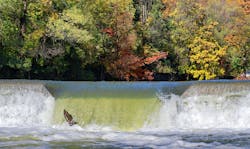Henry Watson Jr. is vice president for Atlas-SSI. Watson can be reached at [email protected].
undefinedIt is important to recognize that all intake screens are different. Understanding water conditions, fish species and screening technology allows for screen designs that meet state and federal regulations concerning entrainment and impingement of aquatic life.
This article will expand on 316(b) and fish-friendly raw water intake solutions, as well as how to get the most efficiency out of those screens, regardless of the manufacturer. The survival of fish can be taken into consideration when it comes to raw water intake solutions, and it should not become a hindrance.
What Is 316(b)
Water intakes can cause adverse environmental impacts by drawing early life stage fish and shellfish into cooling water systems, where the organisms may be harmed by heat, pressure, mechanical stress or chemicals used to clean the cooling system. This is where 316(b) comes in.
Section 316(b) is an offshoot of the 1972 Clean Water Act, which introduced the National Pollutant Discharge Elimination System (NPDES) permit program. On May 19, 2014, Section 316(b) of the Clean Water Act was finalized by the U.S. EPa. The rule regulates the mortality rates for fish and aquatic life that encounter cooling water intake structures at existing power plants, industrial sites, and manufacturing facilities.
Facilities with permits are subject to 316(b), which requires that the location, design, construction and capacity of cooling water intake structures reflect the best technology available for minimizing adverse environmental impacts.
Available Technologies
Today, there are different technology combinations facilities can consider as cost-effective solutions for protecting fish.
- Fixed panel screens with sufficient screen surface area to achieve a through-screen velocity of less than 0.5 feet per second can be used to satisfy the reduced intake velocity requirement.
- With modified traveling screens, the annual average and monthly maximum mortality of impinged fish is between 12 and 31%. If this technology is paired with fine-mesh screens, entrainment protection may also be achieved.
Operational Considerations
The list of potential operational considerations for 316(b) compliance for water or river intake screens is also worth describing. Below are some measures to be considered.
- If capacity factor reductions or unit mothballing results in through-screen velocities that are less than 0.5 feet per second, impingement compliance would be achieved and entrainment losses would be reduced.
- Variable speed drives, flow optimization and targeted outages may also be considered to the extent they provide impingement and entertainment protections that will be recognized by permitting authorities.
- For some water intake screens, performance in terms of impingement and entrainment reductions can be largely driven by the hardiness or fragility of specific species subject to withdrawal at the facility and the extent of debris loading and biofouling.
Fish Are Friends
Understanding the history, technologies and operational considerations involved with 316(b) regulations will help ensure each facility is compliant when it comes to fish-friendly solutions.


